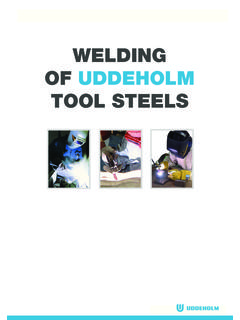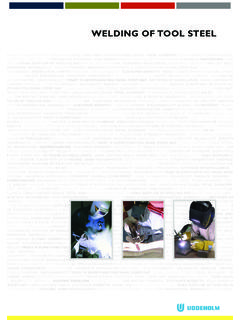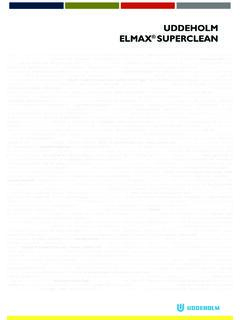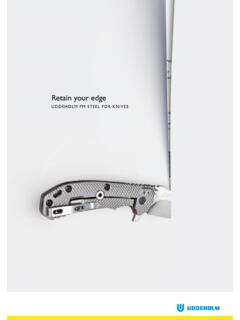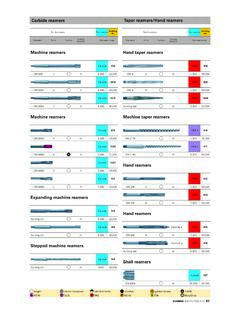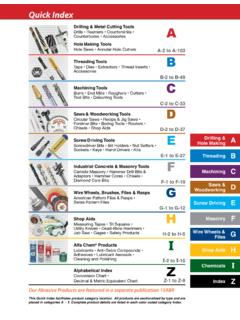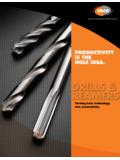Transcription of Uddeholm Sverker 21
1 Uddeholm . Sverker 21. Uddeholm Sverker 21. UDDEHOLMS AB. No part of this publication may be reproduced or transmitted for commercial purposes without permission of the copyright holder. This information is based on our present state of knowledge and is intended to provide general notes on our products and their uses. It should not therefore be construed as a warranty of specific properties of the products described or a warranty for fitness for a particular purpose. Classified according to EU Directive 1999/45/EC. For further information see our Material Safety Data Sheets . Edition 9, 2. Uddeholm Sverker 21. Uddeholm Sverker 21. THE BACKBONE OF COLD WORK TOOLING. The steel grade was developed around 1930 and is still going strong. Ledeburitic 12 % Cr- steel are still the most commonly used tool steel for cold work tooling all over the world. PROPERTIES PROFILE. Uddeholm Sverker 21 is a tool steel with very good abrasive wear resistance but with rather limited cracking resistance.
2 Being the bulk grade for cold work applications there are many advantages such as well established know-how concerning all types of treatments and tool processing. The risk with the popularity is, however, that the grade by routine is used in applications where the properties profile not is entirely appropriate. In such cases normally there are better alternatives like Uddeholm Sleipner, Uddeholm Caldie or Uddeholm Vanadis 4 Extra. APPLICATIONS. The properties profile of Uddeholm Sverker 21 combine to give a steel suitable for the manufacture of medium run tooling for applications where abrasive wear is dominant and the risk of chipping or cracking is not so high, for blanking and forming of thinner, harder work materials. 3. Uddeholm Sverker 21. GENERAL Forming HRC. Tools for: Uddeholm Sverker 21 is a high-carbon, high- Bending, forming, deep-drawing, chromium tool steel alloyed with molybdenum rim-rolling, spinning and flow-forming 56 62.
3 And vanadium characterized by: Coining dies 56 60. High wear resistance Cold extrusion dies 58 60. Punches 56 60. High compressive strength Tube- and section forming rolls; plain rolls 58 62. Good through-hardening properties Tools for powder compaction 58 62. High stability in hardening Dies for moulding of: Good resistance to tempering-back Ceramics, bricks, tiles, grinding wheels, tablets, abrasive plastics 58 62. Thread-rolling dies 58 62. Typical C Si Mn Cr Mo V Cold-heading tools 56 60. analysis Crushing hammers 56 60. Standard Swaging tools 56 60. specification AISI D2, Mandrels for cold drawing of tubes 54 60. Delivery Gauges, measuring tools, guide rails, condition Soft annealed to approx. 210 HB bushes, sleeves, knurling tools, sandblast nozzles 58 62. Colour code Yellow/white PROPERTIES. APPLICATIONS. Uddeholm Sverker 21 is recommended for PHYSICAL DATA. tools requiring very high wear resistance, Hardened and tempered to 62 HRC.
4 Data at combined with moderate toughness (shock- ambient temperature and elevated tempera- resistance). In addition to the applications tures. listed in the product information brochure for Uddeholm Sverker 3, it is used when cutting Temperature 20 C 200 C 400 C. (68 F) (390 F) (750 F). thicker, harder materials; when forming with Density, kg/m3 7 700 7 650 7 600. tools subjected to bending stresses and where lbs/in3 0,277 0,276 0,275. high impact loads are involved. Coefficient of thermal Uddeholm Sverker 21 can be supplied in expansion various finishes, including the hot-rolled, pre- at low temperature tempering machined and fine machined condition. It is per C from 20 C x 10-6 . also available in the form of hollow bar and per F from 68 F x 10-6 . rings. at high temperature tempering per C from 20 C x 10-6 12 x 10-6. per F from 68 F x 10-6 x 10-6. Material Thermal conductivity Material Hardness (HB) W/m C 20,0 21,0 23,0. Cutting thickness <180 >180 Btu in/ft2 h F 139 146 159.
5 HRC HRC. Modulus of elasticity Tools for: MPa 210 000 200 000 180 000. Blanking, fine-blanking, <3 mm (1/8") 60 62 58 60 ksi 30 450 29 000 26 100. punching, cropping, 3 6 mm shearing, trimming, (1/8 1/4") 58 60 54 56 Specific heat clipping J/kg C 460 . Btu/lb F . Short, cold shears. Shredding knives for waste plastics. Granulator knives 56 60. Circular shears 58 60 COMPRESSIVE STRENGTH. Clipping, trimming tools Hot 58 60 The figures are to be considered as approxi- for forgings Cold 56 58 mate. Wood milling cutters, reamers, broaches 58 60. Hardness Compressive yield strength, Rc0,2. HRC MPa ksi 62 2200 319. 60 2150 312. 55 1900 276. 50 1650 239. 4. Uddeholm Sverker 21. HEAT TREATMENT HARDNESS AS A FUNCTION OF. AUSTENITIZING TEMPERATURE. SOFT ANNEALING Grain size ASTM Hardness, HRC Retained austenite %. Protect the steel and heat through to 850 C. 10 70. (1560 F). Then cool in the furnace at 10 C Grain size 9 68. (20 F) per hour to 650 C (1200 F), then freely 8 66 40.
6 In air. 7 64. 6 62 30. 5 60. STRESS-RELIEVING 4. 58 20. 56. After rough machining the tool should be 3. 54 10. heated through to 650 C (1200 F), holding 2. 52 Retained austenite time 2 hours. Cool slowly to 500 C (930 F), 1. 50. then freely in air. 960 980 1000 1020 1040 1060 1080 C. 1760 1800 1830 1870 1900 1940 1980 F. Austenitizing temperature HARDENING. Preheating temperature: 650 750 C (1110 TEMPERING. 1290 F). Choose the tempering temperature according Austenitizing temperature: 990 1080 C (1810 . to the hardness required by reference to the 1980 F) but usually 1000 1040 C (1830 . tempering graph. Temper twice with inter- 1905 F). mediate cooling to room temperature. Lowest Temperature Soaking* time Hardness before tempering temperature 180 C (360 F). Holding C F minutes tempering time at temperature minimum 2 hours. 990 1815 60 approx. 63 HRC. 1010 1850 45 approx. 64 HRC TEMPERING GRAPH. 1030 1885 30 approx. 65 HRC. 1080 1975 30 approx.
7 64 HRC. Hardness HRC Retained austenite %. * Soaking time = time at austenitizing temperature after the 70. tool is fully heated through Austenitizing temp. 1080 C (1975 F). 65. 1050 C (1920 F). Protect the part against decarburization and 60. oxidation during hardening. 55 25. 50 20. Retained austenite 1080 C (1980 F). 45 15. QUENCHING MEDIA. 40 10. Oil (Only very simple geometries). 35 5. Vacuum (high speed gas). Forced air/gas 30. 100 200 300 400 500 600 C. Martempering bath or fluidized bed at 180 210 390 570 750 930 1110 F. 500 C (360 930 F), then cooling in air Tempering temperature Note: Temper the tool as soon as its tempera- Hardness HRC Retained austenite %. ture reaches 50 70 C (120 160 F). Uddeholm 70. Austenitizing temp. Sverker 21 hardens through in all standard 1020 C (1870 F). 65. sizes. 990 C (1815 F). 60. 55 25. 50 20. 45 15. Retained austenite 1020 C (1870 F). 40 10. The tempering curves are obtained after heat treatment 35 5.
8 Of samples with a size of 15 x 15 x 40 mm, cooling in 30. forced air. Lower hardness can be expected after heat 100 200 300 400 500 600 C. treatment of tools and dies due to factors like actual tool size and heat treatment parameters. 210 390 570 750 930 1110 F. Tempering temperature 5. Uddeholm Sverker 21. DIMENSIONAL CHANGES AFTER SUB-ZERO TREATMENT. HARDENING AND TEMPERING Pieces requiring maximum dimensional Heat treatment: Austenitizing temperature stability should be sub-zero treated, as volume 1020 C (1870 F), 30 minutes, cooling in changes may occur in the course of time. This vacuum equipment with 2 bar overpressure. applies, for example, to measuring tools like Tempering at various temperatures 2 x 2 gauges and certain structural components. hours. Immediately after quenching the piece should be sub-zero treated to between -70. Sample, 80 x 80 x 80 mm. and -80 C (-95 to -110 F) soaking time Dimensional changes % 3 4 hours followed by tempering.
9 Sub-zero + treatment will give a hardness increase of + 1 3 HRC. Avoid intricate shapes as there will Length + 1020 C (1870 F) be risk of cracking. + Aging occurs at 110 140 C during 25 . 0 100 hours. Width 1020 C (1870 F). Thickness NITRIDING AND NITROCARBURIZING. 1020 C(1870 F). Nitriding will give a hard surface layer which is 200 250 300 350 400 450 500 550 C. 390 480 570 660 750 840 930 1020 F very resistant to wear and erosion, and also Tempering temperature increases corrosion resistance. A temperature of 525 C (975 F) gives a surface hardness of Note: Recommended machining allowance approx. 1250 HV1. Depth of case Nitriding temperature Nitriding time approx. C F hours mm in 525 980 20 525 980 30 525 980 60 2 hours Nitrocarburizing at 570 C (1060 F). gives a surface hardness of approx. 950 HV1. The casedepth having this hardness will be 10 20 m ( " "). The figures refers to hardened and tempered material. Progressive tool. 6.
10 Uddeholm Sverker 21. MACHINING MILLING. FACE AND SQUARE SHOULDER. RECOMMENDATION FACE MILLING. The cutting data below are to be considered Milling with carbide as guiding values which must be adapted to Cutting data parameters Rough milling Fine milling existing local conditions. More detailed Cutting speed, (vc). information can be found in Uddeholm Cut- m/min. 90 130 130 180. ting Data Recommendations . 295 426 426 590. Feed, (fz). mm/tooth TURNING in/tooth Turning Turning Depth of cut. (ap). with carbide with high mm 2 4 2. Cutting data speed steel inch parameters Rough turning Fine turning Fine turning Carbide designation, ISO K20, P20* K20, P20*. Cutting * Use a wear resistant Al2O3 coated carbide grade speed (vc). m/min. 100 150 150 200 12 15. 328 492 492 656 40 50 END MILLING. Feed (f). mm/r Type of milling Carbide Depth of Cutting data Solid indexable High speed cut (ap) parameters carbide insert steel mm 2 6 2 2. Cutting inch speed (vc).


